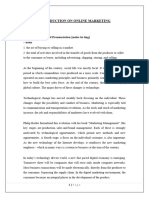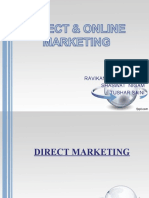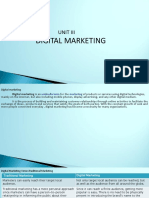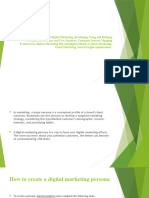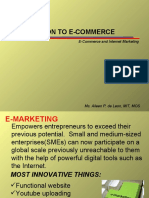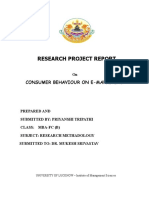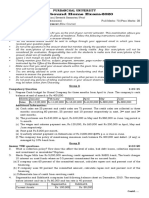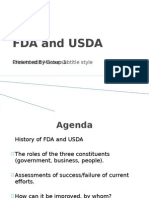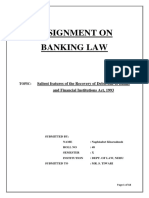E-Commerce Unit-6: E-Marketing
E-Commerce Unit-6: E-Marketing
Uploaded by
Aakash RegmiCopyright:
Available Formats
E-Commerce Unit-6: E-Marketing
E-Commerce Unit-6: E-Marketing
Uploaded by
Aakash RegmiOriginal Title
Copyright
Available Formats
Share this document
Did you find this document useful?
Is this content inappropriate?
Copyright:
Available Formats
E-Commerce Unit-6: E-Marketing
E-Commerce Unit-6: E-Marketing
Uploaded by
Aakash RegmiCopyright:
Available Formats
E-Commerce Unit-6: E-Marketing
Introduction
With the Internet growing at an astonishing pace in recent years, marketers around the world
are racing to take advantage of its interactive nature, to communicate and foster exchanges and
relationships with customers, suppliers, and the public. Also, the amount of transactions on the
Internet is increasing exponentially.
The accelerating confluence of traditional print and broadcast media with new digital media
like the Internet has created dynamic new channels for marketers. At the same time, advertisers
have begun demanding greater economic efficiency in reaching target customers. The Internet
is changing the design and implementation of marketing strategies. This dynamic technology
provides marketers with efficient and powerful methods of designing, promoting, and
distributing products, conducting research, and gathering market information.
E-marketing can include any Internet-based promotion, including websites, targeted e-mail,
Internet bulletin-boards, sites where customers can dial-in and download files, and so on.
Traditional Marketing
If marketing is whatever you do to promote the sale of your products or services, then it should
include:
1. Market research― from competitive information-gathering to industry awareness to
soliciting customer opinions and preferences.
2. Publicity― from press releases to the positioning of your company and its offerings in
the marketplace.
3. Advertising― that is text-based and graphic-based.
4. Sales― including distribution and merchandising.
5. Customer service and customer support.
Traditional marketing seems to fall far short of certain problems associated with it, which are
listed as follows:
1. Traditional marketing is often expensive.
It can cost a lot of money to produce and print brochures, product sheets, and catalogues.
It is also expensive to keep support personnel on hand to answer inquiries from
customers, and it costs a lot of money in postage and shipping fees to send information to
potential customers.
2. Traditional marketing can be a very time-consuming process.
Mistakes have to be corrected; you have to go back to the ad agency or printer to revise,
and/or delete, and you often have to wait long for an ad you have placed to appear in a
publication.
3. Traditional marketing often has a “hit and miss” quality.
Marketers often send out bulk of mails to customers and yet receive a tiny response.
Moreover they are not sure of fulfilling the taste of the customers and coming across the
right customer.
Businesses have always made their presence felt by establishing shops, factories, warehouses,
and office buildings. An organization’s presence is the public image it presents to its
stakeholders. So, companies always try to make their mark before worrying about the image
they project. On the Web, making one’s presence felt is much more important. The only
contact that customers and the stakeholders have with a firm on the Web might be its website.
Therefore, creating an effective and appealing Web page in the website is essential even for the
smallest and the newest firm operating on the Web.
Compilation: Ajay K Shah (Associate Professor, Purbanchal University) 1
E-Commerce Unit-6: E-Marketing
Objectives of E-marketing site
An effective site is the one that creates an attractive presence that meets the objectives of the
business or the organization. These objectives include:
• Attracting visitors to the website
• Making the site interesting enough so that visitors stay and explore
• Convincing visitors to follow the site’s links to obtain information
• Creating an impression consistent with the organization’s desired image
• Building a trustworthy relationship with visitors
• Reinforcing positive images that the visitor might already have about the organization
• Encouraging visitors to return to the site
Reasons for visiting a Website
Businesses that are successful on the Web realize that every visitor to their website is a
potential customer. Customers might visit a company’s website with some of the possible
reasons listed as below:
• Learning about products or services that the company offers
• Buying the products or services that the company offers
• Obtaining information about warranties or service and repair policies for purchased products
• Obtaining general information about the company or organization
• Obtaining financial information for making an investment
• Identifying the people who manages the company or organization
• Obtaining contact information of a person or a department in the organization
Maintaining a Website
Creating a website that meets the needs of visitors with such a wide range of motivations can
be challenging. Not only do website visitors arrive with different needs, but also they arrive
with different experience and expectation levels. To be successful in conveying a proper image
and offering right information to potential customers, businesses should try to meet the
following goals when constructing their websites:
• Convey an integrated image of the organization
• Offer easily accessible facts about the organization
• Allow visitors to experience the site in different ways at different levels
• Provide visitors with a meaningful, two-way interaction link with the organization
• Sustain visitor attention and encourage return visits
• Offer easily accessible information about products and services and how to use them
Online Marketing
Online marketing means using the power of online networks, computer communications and
digital interactive media to reach your marketing objectives. Online marketing will not replace
traditional forms of marketing anyway. Instead, it will both add and subtract from today’s
marketing mix. It will add more interactivity. But it will subtract costs. It will add more
customer choices. But it will remove marketing’s dependence on paper. It will add
“information value” to products and services. But it will take away barriers to starting a
business or extending a business into international markets.
Compilation: Ajay K Shah (Associate Professor, Purbanchal University) 2
E-Commerce Unit-6: E-Marketing
Advantages of Online Marketing
1. Online marketing can save money and help you stretch your marketing budget. Electronic
versions of catalogues, brochures, and specification sheets do not have to be printed,
packaged, stored, or shipped. These can be updated online, and hence, you need not have to
send them back to the printer for changes.
2. Online marketing can save time and cut steps from the marketing process. Marketers no
longer have to wait for one of their sales representatives to give them the desired
information. They can get it online on their own. E-mail allows you to exchange
information with potential buyers quickly.
3. Online marketing gives customers another way to buy, while enabling them to take control
of the purchasing process. Smart marketers can influence the interactivity of the online
communications by encouraging the customer to get engaged in making decisions about the
product. Customers can choose the color, select the shipping method, and place the
purchase orders themselves.
4. Online marketing can be information-rich and interactive. It attracts information-hungry
buyers and analytical buyers. It allows buyers and current customers to search and locate
the information they need quickly.
5. Online marketing erases the time and distance barriers that get in the way of conducting
business transactions with customers in other countries, thus creating an instant global
community.
6. Online marketing can lower barriers to entry and offer equal opportunity for access. When
you are doing business online, differences related to the ethnic background or gender or
even the size of business do not seem to matter as much. The online world is a great
leveler.
7. Online marketing can be continuously available. One of the best advantages of an online
information server is that it is always on the job, twenty-four hours a day, 365 days a year.
E-advertising
Advertising is a worldwide industry. Marketing plans and strategies finally end in advertising.
It is advertising which exposes the product to the world and places it in a platform for the
target customer to view. It gives the product visibility and helps boosts its sales. Advertising, in
general, can be classified into two trends: Above-the-line (ATL) and Below-the-line (BTL).
ATL covers all the advertising done through media. BTL stands for all the promotions–public
relations, sponsorships, merchandising, etc. In traditional marketing, mostly ATL is practiced.
The following media are the ATL modes of advertising:
Print Medium: Newspapers, Magazines, Yellow Pages, Posters and Billboards
TV & Radio: All kinds of TV and Radio spots
Other Communications: All kinds of mailers and brochures
Advertisers hoped that potential buyers would remember their slogan or jingle long enough to
make a trip to the store and purchase the product. The trend of advertising has changed now
with the advent of interactivity. The new concept of ‘interactivity’ has overpowered the
traditional concept of advertising, by putting the buyer in the driver’s seat. Interactivity allows
consumers to increase their control over the buying process. We have become more selective
today, and interactivity gives us that option. Thus, the audience is not captive anymore, and the
marketers would not have to work harder than before to entice them. The marketing efforts will
have to be information-rich and user-friendly.
Web-based advertising has become an important part of a company’s media mix. Numerous
companies are committing large advertising budgets to the Internet.
Compilation: Ajay K Shah (Associate Professor, Purbanchal University) 3
E-Commerce Unit-6: E-Marketing
Followings are the reasons for the growing importance of e-advertisements:
1. People increasingly prefer to surf the Internet rather than to watch TV or listen radio.
2. The target audience goes to the advertisement, rather than the other way around.
3. Development of business search engines by companies.
4. The growth of e-business.
5. The Internet is not geographically restricted.
Various means of Advertising
E-mail. It is a low cost advertising and has ability to reach a wide variety of targeted
audience. Most companies develop a customer database, to whom they send e-mails.
Banners. It is the most commonly used form of advertising which contains a short text or a
graphic message to promote a product.
Skyscrapers. These are the extra-long skinny ads running down the right or left side of a
website.
Banner Swapping. It is nothing but a direct exchange of links between websites.
Streaming Video and Audio. Companies insert ads for marketers into music and video
clips, as customers listen to them.
Mini-sites, Pop-ups. These ads burst upon the screens, allowing companies to dish up
games and product information.
Interstitials. When visiting some site, a new window called interstitial opens in the browser
demanding your attention because you must click on them, even if only to close the
window.
Sponsorships. This also takes visitors from an ad site to a site where purchasing can be
done and the purchase is sponsored by the first site by creating value for visitors to that
site.
Coupons. Many companies offer their members discount coupons which they can print out
and then use for both online and offline retailers.
The Browsing Behavior Model
Customers of an e-commerce site interact with it through a series of consecutive and related
requests made during a single visit called session. Within a session, customers can issue
requests of different types, such as Login, Browse, Search, Add to Shopping Cart, or Pay.
Different customers may navigate through the site in different ways and therefore may invoke
the different functions provided by the site. Some customers may be heavy buyers while others
may be occasional buyers who do extensive and browsing, but rarely buy anything from the
site. The customer’s behavior while interacting with an e-commerce site has impacts on the IT
resources of the site. So, it is important to be able to characterize the behavior of customers or
group of customers of an e-commerce site.
The customer model captures elements of user behavior in terms of navigational patterns, e-
commerce functions used, frequency of access to the various e-commerce functions, and the
times between accesses to the various services offered by the site.
Browsing Behavior Model of an Online Video Store
An online video store is taken as an example that can well explain about the user behavior
model of an e-commerce site. Followings are the necessary functions that customers follow:
1. Connect to the home page and browse the site by following the links to bestseller videos and
promotions of the week per video category.
2. Search for titles according to various criteria including keywords and title.
Compilation: Ajay K Shah (Associate Professor, Purbanchal University) 4
E-Commerce Unit-6: E-Marketing
3. Select on of the videos that comes after performing a search and view additional information
such as a brief description of the product/products, price, shipping time, ranking, and reviews.
4. Register as a new customer of the virtual video store. For this, a user has to provide a
username and password, payment information (credit card number), mailing address, and e-
mail address.
5. Login with a username and password.
6. Add items to the shopping cart.
7. Pay for the items added to the shopping cart.
The given model is in the form of a graph and is called the Browser Behavior Model
Graph (BBMG). According to this model, a customer may be in different states, as he/she
may be browsing, searching, registering as a new customer, logging in, adding video items to
the shopping cart, selecting the result of a search, or paying the order. This model captures the
possible transitions between the states in which a customer may be found. The nodes of the
BBMG, represented by rectangles, depict the states a customer can be in during a visit to the
e-commerce site. Arrows connecting the states indicate the possible transitions between them.
Followings are the different states a customer visits while browsing an e-commerce site:
Entry This is a special state that immediately precedes a customer’s entry to the online store. This
state does not correspond to any action initiated by the customer.
Home This is the state a customer is in, after selecting the URL for the site’s home page.
Login A customer moves to this state after requesting a login to the site.
Register To have an account for registering with the online videostore, the customer selects the
proper link for the registration page, thus making a transition to this state.
Search A customer goes to this state after issuing a search request.
Browse A customer reaches to this state after selecting one of the links available at the site to view
any of the pages of the site. There are a number of such links available.
Select A search returns a list of zero or more links to videos. By selecting one of these links, a
customer moves to this state.
Add to Cart A customer moves to this state after selecting the button that adds a selected video to
the shopping cart.
Pay (Billing) When ready to pay for the items in the shopping cart, the customer moves to this
state.
Exit Customers may leave the site from any state. Thus, there is a transition from all states, except
the entry state, to the exit state.
Fig. States and Transitions of the BBMG for the virtual videostore.
Compilation: Ajay K Shah (Associate Professor, Purbanchal University) 5
You might also like
- Coop Development Plan 2016 2018Document5 pagesCoop Development Plan 2016 2018Jefrey Gucela100% (5)
- Case Zanzibar Treason CAT 2000Document21 pagesCase Zanzibar Treason CAT 2000jonas msigalaNo ratings yet
- 7 O's of Lifebuoy Soap ProductDocument7 pages7 O's of Lifebuoy Soap ProductĒrmias ÁlemayehuNo ratings yet
- Strategies For Recruiting Volunteers For Tutor/mentor ProgramsDocument33 pagesStrategies For Recruiting Volunteers For Tutor/mentor ProgramsDaniel F. Bassill100% (1)
- E-Commerce Mod 2Document9 pagesE-Commerce Mod 2sanskarsatwik100No ratings yet
- Online MarketingDocument87 pagesOnline Marketingalpa.sharmaNo ratings yet
- Magesh Chapter 1 and 2 3Document22 pagesMagesh Chapter 1 and 2 3G.praveen KumarNo ratings yet
- Prakash 2A Assignment1Document5 pagesPrakash 2A Assignment1Prakash ShuklaNo ratings yet
- E-COM UNIT 5 NOTESDocument11 pagesE-COM UNIT 5 NOTESSaritha ReddyNo ratings yet
- MMC Unit 1Document7 pagesMMC Unit 1vaibhavsreenivas03No ratings yet
- Unit IDocument11 pagesUnit IVidhyaBalaNo ratings yet
- BY: Ravikant Khandelwal Shaswat Nigam Tushar SainiDocument39 pagesBY: Ravikant Khandelwal Shaswat Nigam Tushar SainiShaswat NigamNo ratings yet
- Direct and Online MarketingDocument39 pagesDirect and Online MarketingShaswat Nigam0% (1)
- Lesson 7Document5 pagesLesson 7Elisabet Ruth LuyaNo ratings yet
- E-Marketing (NTPEL) 20SS02IT002Document13 pagesE-Marketing (NTPEL) 20SS02IT002Jaivik AkbariNo ratings yet
- B2B Marketing Unit 2Document56 pagesB2B Marketing Unit 2ritiagrawal845No ratings yet
- Magesh Chapter All Original ChaptersDocument43 pagesMagesh Chapter All Original ChaptersG.praveen KumarNo ratings yet
- Unit-2 (KMBNMK03 B2B and Services Marketing) : Role of Marketing Communications in B2B MarketsDocument44 pagesUnit-2 (KMBNMK03 B2B and Services Marketing) : Role of Marketing Communications in B2B MarketsDivyanshuNo ratings yet
- All Chapter Digital MarketingDocument28 pagesAll Chapter Digital MarketingVisal SasidharanNo ratings yet
- Digital Marketing - Unit 1Document39 pagesDigital Marketing - Unit 1Dr. Mithra VNo ratings yet
- Apoorv 1Document37 pagesApoorv 1Ahuja AbhishekNo ratings yet
- Report Transcript - Lugo - e MarketingDocument10 pagesReport Transcript - Lugo - e MarketingCba Jrmsu-KatipunanNo ratings yet
- Digital Marketing Module IDocument160 pagesDigital Marketing Module Ideepakthakur116350No ratings yet
- Executive SummaryDocument3 pagesExecutive SummaryAyush SharmaNo ratings yet
- Digital MarketingDocument55 pagesDigital Marketingshri kantNo ratings yet
- 1 0-IntroductionDocument23 pages1 0-IntroductionKarthik AnandNo ratings yet
- Managing Personal CommunicationDocument4 pagesManaging Personal CommunicationEka Darmadi100% (1)
- Topic:-Electronic Marketing: AdeccoDocument8 pagesTopic:-Electronic Marketing: AdeccoRahul GuptaNo ratings yet
- Lesson 1 - Internet MarketingDocument13 pagesLesson 1 - Internet MarketingmambonyiroNo ratings yet
- Marketing Management Project: Submitted To - Submitted byDocument14 pagesMarketing Management Project: Submitted To - Submitted byNihariKa YadavNo ratings yet
- Fundamental of Digital MarketingDocument10 pagesFundamental of Digital MarketingNikhil GuptaNo ratings yet
- Chapter VIl Framework For Web MarketingDocument38 pagesChapter VIl Framework For Web MarketingJared L. Claveria100% (1)
- Sibusisiwe Matavire Task 2 Digital Marketing 40207585 July 2023Document18 pagesSibusisiwe Matavire Task 2 Digital Marketing 40207585 July 2023Mikaela MatavireNo ratings yet
- Digital MarketingDocument8 pagesDigital MarketingManisha Yadav0% (1)
- Lecture08 Introducing Digital MarketingDocument18 pagesLecture08 Introducing Digital MarketingUswa JamilNo ratings yet
- Digital Marketing Chapter 01Document10 pagesDigital Marketing Chapter 01Maisha MunawaraNo ratings yet
- Management Theory and Practice-SolvedDocument7 pagesManagement Theory and Practice-SolvedNMIMS GANo ratings yet
- Digital MarketingDocument41 pagesDigital MarketingBipin GurungNo ratings yet
- Module 1 - Social Media Marketing Csa3068Document92 pagesModule 1 - Social Media Marketing Csa3068yolaxa1297No ratings yet
- Module 2 SMM RevisedDocument67 pagesModule 2 SMM Revisedyolaxa1297No ratings yet
- Unit 1Document12 pagesUnit 1CS0126 VINAY KUMARNo ratings yet
- Module-5 Recent Trends in Marketing Online MarketingDocument7 pagesModule-5 Recent Trends in Marketing Online Marketingmurshidaman3No ratings yet
- What Is Digital Marketing?Document11 pagesWhat Is Digital Marketing?Aziz JedidiNo ratings yet
- Digital Marketing for students.Document99 pagesDigital Marketing for students.saravana kumar s sNo ratings yet
- Introduction To Social Media: Online MarketingDocument21 pagesIntroduction To Social Media: Online MarketingSateesh KumarNo ratings yet
- E Marketing - BBA 2nd Batch Touhid SirDocument31 pagesE Marketing - BBA 2nd Batch Touhid SirMd. Touhidul IslamNo ratings yet
- ELEC3 Introduction Lecture1Document28 pagesELEC3 Introduction Lecture1Aileen P. de LeonNo ratings yet
- Assignment BDocument7 pagesAssignment BRasheeqah MirzaNo ratings yet
- Online Marketing in India - Amazon IndiaDocument83 pagesOnline Marketing in India - Amazon India8kh7q5y8cwNo ratings yet
- Daman Yadav (10) Project ReportDocument24 pagesDaman Yadav (10) Project ReportDaman YadavNo ratings yet
- Online MarketingDocument56 pagesOnline MarketingcityNo ratings yet
- IM 1 - Ronishka MaharjanDocument8 pagesIM 1 - Ronishka MaharjanRoni MaharjanNo ratings yet
- Marketing ChannelsDocument17 pagesMarketing Channelsatishay jainNo ratings yet
- Inter MarketingDocument21 pagesInter MarketingChaitanya ShaligramNo ratings yet
- E Marketing NewwwwwDocument39 pagesE Marketing Newwwwwsaumya pandeyNo ratings yet
- Endterm Assessment IN Empowerment Technologies One Note ActivityDocument10 pagesEndterm Assessment IN Empowerment Technologies One Note ActivityKristina RojasNo ratings yet
- UntitledDocument7 pagesUntitledPriyanshu SoniNo ratings yet
- English For Marketing - Group ProjectDocument23 pagesEnglish For Marketing - Group ProjectNguyễn Thu HiềnNo ratings yet
- CLG ProjectDocument31 pagesCLG ProjectGoddamnking 123No ratings yet
- E - Marketing - Challenges and Opportunities: VOL: 12, December, 2015Document4 pagesE - Marketing - Challenges and Opportunities: VOL: 12, December, 2015Saini AashishNo ratings yet
- SynopsisDocument12 pagesSynopsisTony HobbsNo ratings yet
- Marketing and Brand Management MaterialDocument43 pagesMarketing and Brand Management Materialaditimehendiratta1759No ratings yet
- Unit 1 FODMDocument45 pagesUnit 1 FODMwankhedemiditNo ratings yet
- PaymentDocument1 pagePaymentAakash RegmiNo ratings yet
- Time-Bound Home Exam-2020: Purbanchal UniversityDocument2 pagesTime-Bound Home Exam-2020: Purbanchal UniversityAakash RegmiNo ratings yet
- Security Valuations - Stocks EZDocument9 pagesSecurity Valuations - Stocks EZAakash RegmiNo ratings yet
- Unit-1 Introduction To E-Commerce 1Document45 pagesUnit-1 Introduction To E-Commerce 1Aakash RegmiNo ratings yet
- E-Commerce ManagementMindsDocument2 pagesE-Commerce ManagementMindsAakash RegmiNo ratings yet
- Asiavest Merchant Bankers vs. CA, GR No. 110263-CoLDocument8 pagesAsiavest Merchant Bankers vs. CA, GR No. 110263-CoLHeberdon LitaNo ratings yet
- Criminal Orders HC-RulesDocument346 pagesCriminal Orders HC-RulesAdv Rana Abuzar GhafariNo ratings yet
- First Division: Synopsis SynopsisDocument18 pagesFirst Division: Synopsis SynopsisPatrickHidalgoNo ratings yet
- Roma Women'S Voices and Silences On Unjust Power Regimes: Enikő VinczeDocument17 pagesRoma Women'S Voices and Silences On Unjust Power Regimes: Enikő VinczeIov Claudia AnamariaNo ratings yet
- Comms DirectorDocument3 pagesComms DirectorSteven PargettNo ratings yet
- People Vs GenosaDocument3 pagesPeople Vs GenosaCelver Joy Gaviola Tamparia100% (1)
- Urgent Updated Notice and Actions 4/10: South Bronx NEWS! Casa Atabex Ache Asked To Vacate Their Space!Document1 pageUrgent Updated Notice and Actions 4/10: South Bronx NEWS! Casa Atabex Ache Asked To Vacate Their Space!Casa Atabex AchéNo ratings yet
- People Vs Ignacio PDFDocument6 pagesPeople Vs Ignacio PDFVeen Galicinao FernandezNo ratings yet
- Eugenio Vs CSCDocument1 pageEugenio Vs CSCKier ArqueNo ratings yet
- Cyber Security BibliographyDocument6 pagesCyber Security BibliographyhkingsmaNo ratings yet
- Exam Q4 Media and Information LiteracyDocument2 pagesExam Q4 Media and Information LiteracyCK Cortel JrNo ratings yet
- DRAFT - Joson Vs COA - 04052019Document3 pagesDRAFT - Joson Vs COA - 04052019Sai PastranaNo ratings yet
- 09 Chaptetr5Document36 pages09 Chaptetr5tayyaba redaNo ratings yet
- Rural Development 5 PDFDocument153 pagesRural Development 5 PDFAncy RajNo ratings yet
- Notice: Radio Broadcasting Services AM or FM Proposals To Change The Community of LicenseDocument2 pagesNotice: Radio Broadcasting Services AM or FM Proposals To Change The Community of LicenseJustia.comNo ratings yet
- FDA and UsdaDocument14 pagesFDA and UsdaXin ZhangNo ratings yet
- Marketing PlanDocument2 pagesMarketing PlanJonahLyn CeriloNo ratings yet
- Ambit 2017 BiosDocument8 pagesAmbit 2017 BiosBryan PattenNo ratings yet
- Introduction To Kymlicka, Multicultural CitizenshipDocument7 pagesIntroduction To Kymlicka, Multicultural CitizenshipCahya IsraNo ratings yet
- Assignment On Banking Law: Salient Features of The Recovery of Debts Due To Banks and Financial Institutions Act, 1993Document18 pagesAssignment On Banking Law: Salient Features of The Recovery of Debts Due To Banks and Financial Institutions Act, 1993Arjun ZmNo ratings yet
- The Power of Social MediaDocument2 pagesThe Power of Social MediaMaria PovedaNo ratings yet
- Liberalism Cheat SheetDocument1 pageLiberalism Cheat SheetKelvinlim0% (1)
- The Free Speech JournalDocument12 pagesThe Free Speech Journalaltlawforum100% (4)
- Marketing Budget TemplateDocument48 pagesMarketing Budget TemplateIvanNo ratings yet
- Vinuya Vs Romulo DigestDocument1 pageVinuya Vs Romulo DigestDonn100% (3)
- McKinney - Letter To President ClintonDocument4 pagesMcKinney - Letter To President Clintonragleta1406No ratings yet





